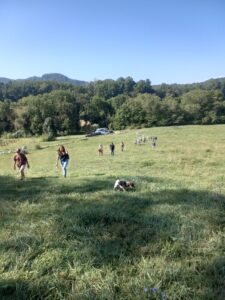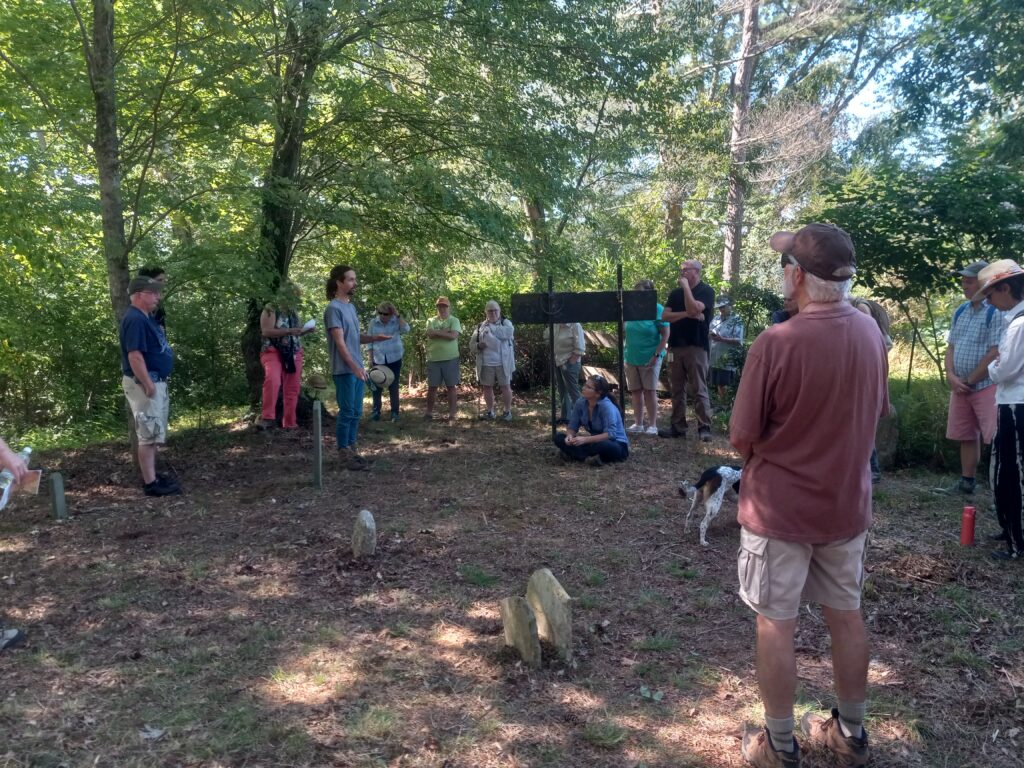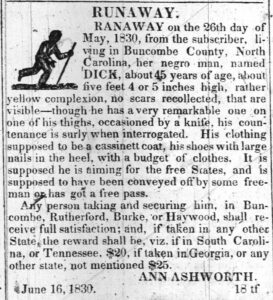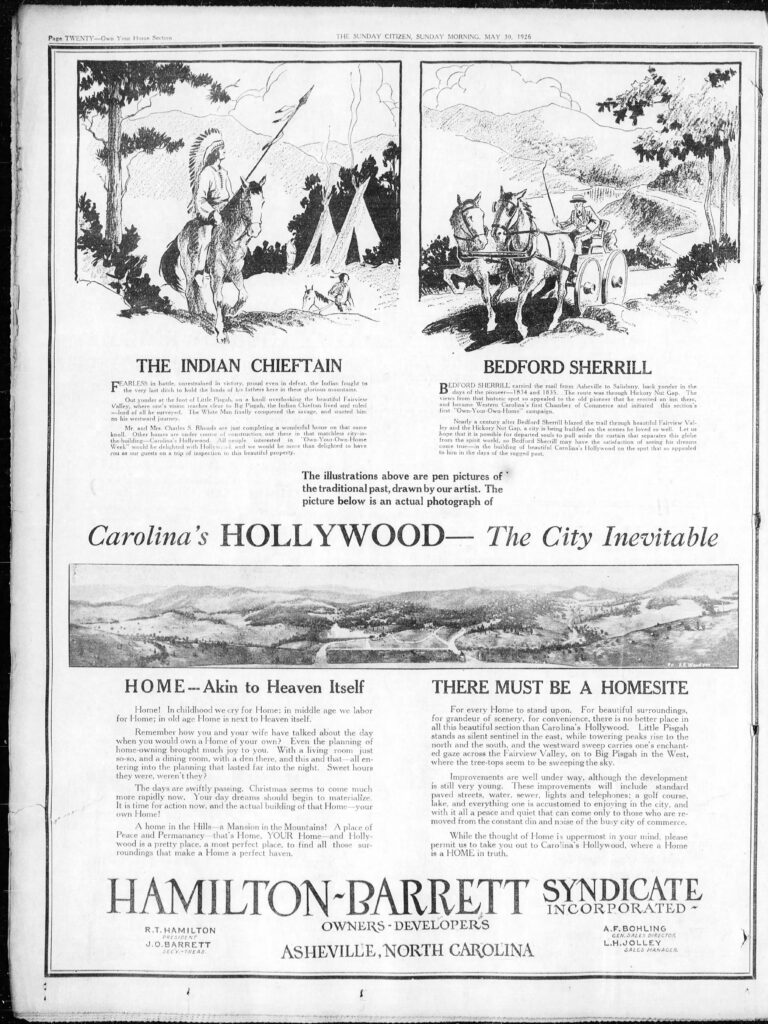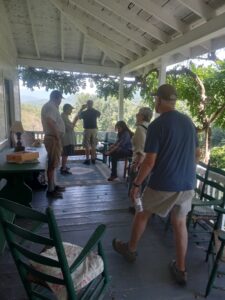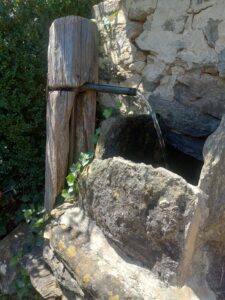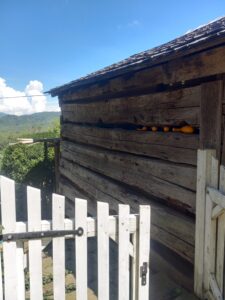Recap and Notes for Ashworth Cemetery and Sherrill’s Inn
Trevor Freeman – Asheville Museum of History Public Programs Director
This is the second year we at the Asheville Museum of History have hosted a cemetery series, and this tour was the second event in the 3-part 2023 iteration.
When we did the cemetery series last year, we knew people were very interested in cemeteries, but wanted to know, “why?” We found it is not just the macabre, or any haunted lore; It’s the people and stories told by these markers and burial places that seem to draw everyone in.
I made it the goal this year to humanize history, as that’s what we were doing all along. We often hear or read about the “great men” or prominent figures, but then large groups of people in history – revolutionaries, serfs, the enslaved, soldiers, Natives, pirates, hillbillies, etc. – are largely nameless and faceless. Yet their stories are intertwined with much larger trends and patterns – many of them collectively helped to shape history. Often, these people have passed without any mark, and stones are all that remain, if even that.
A great example of what we hope to achieve with this series is exemplified by a 2023 article in the Bitter Southerner Magazine written by WNC writer Jeremy B. Jones. He penned an obituary for a quite ordinary life that was nevertheless vibrant and full of meaning.
Recap
- Last week, we toured Brittain Presbyterian Church graveyard and the nearby site where Loyalists were executed after Kings Mountain in 1780
- Brittain Church was founded 1768, the first in WNC.
- The church and graveyard gave us the chance to talk about how land was taken from Cherokees and how settlers first migrated to the WNC foothills down the Great Wagon Road with lots of examples in that graveyard.
- Seeing Patriot burials in graveyard and then unknown mass burial site of executed Loyalists who fought in same battle gave us a chance to explore how the American Revolution played out in the foothills and mountains.
Ashworth Cemetery Overview
On the tour, we explored the early push of settlers into and over the Blue Ridge right after the American Revolution and new treaties with the Cherokee. We looked at the arrival of African-descended enslaved people into the region, land speculation and continued migration, the early road and stagecoach network, and also the legends of healing women or mountain witches. We strove to put some names to those bigger patterns.
We were also lucky on this tour to have several descendants, community members, and stewards of the land join us and share some of their own oral history passed down to them. Oral history like this is invaluable to understanding places and people which/whom were not typically documented.
So what’s the difference in a cemetery and graveyard?
Graveyards are typically associated with a church, while cemeteries may be on family or public lands of some sort. Before large numbers of churches were erected in the mountains, many communities and families buried their loved ones in plots given by someone in the area. Sometimes family cemeteries later became associated with or used by a church. Despite the large number of church graveyards in the mountains, there are also a surprising number of small family or community burial grounds, many of which are unmarked and overgrown, but several of which are still maintained and cared for by descendants and neighbors, and some of which are still used.
While we often know more about graveyards because of church histories, more often than not, oral history and crowd-sourced genealogy are our best (if not only) means of learning about family cemeteries.
Cemetery
- This cemetery is commonly either called the Ashworth cemetery or the old pioneer cemetery.
- There are believed to be at least 9 original burials ranging from 1787 (Elizabeth Ashe McBrayer) to 1855 (Celia Nettles Ashworth).
- Among those are 4 Ashworths and 5 McBrayers or those who married into the McBrayer family.
- There is an ongoing connection to the land though and a few new burials in the cemetery as well.
- There is also a possibility several unknown persons were buried here at some point.
Cherokee Land
- Here, as everywhere we venture in WNC, is Cherokee land. The Aniwviya – meaning principal people – as Cherokees call themselves, have been here thousands of years. And of course, that means they also did a great deal of burying deceased loved ones themselves.
- Archaeological evidence suggests the ancestors of the Cherokee moved south from the Great Lakes region to this area of the Southern Appalachians more than 10,000 years ago.
- Part of a vibrant and dynamic network with other peoples across the Southeast, long before any Europeans arrived.
- This area we are in today was not the site of any known towns, but was part of Cherokee hunting and harvesting lands.
- But, Cherokee stories tell of the importance of this area and the route through the Hickory Nut Gorge as Cherokees traded, negotiated, and sometimes fought with people to the east.
- As presence of numerous forts in the area suggest, including one reportedly built where Sherrill’s Inn now stands, the Cherokee did not easily give up their lands to the squatters and they were not passive observers, but active participants, negotiators, warriors, and diplomats during these several decades around the birth of the United States.
- In 1763 at the end of the French and Indian or 7 Years War, King George III issued a proclamation barring white settlement west of the divide where waters flow west to the Mississippi – the Eastern Continental Divide – which the Ashworth cemetery is about 1.5 miles west of.
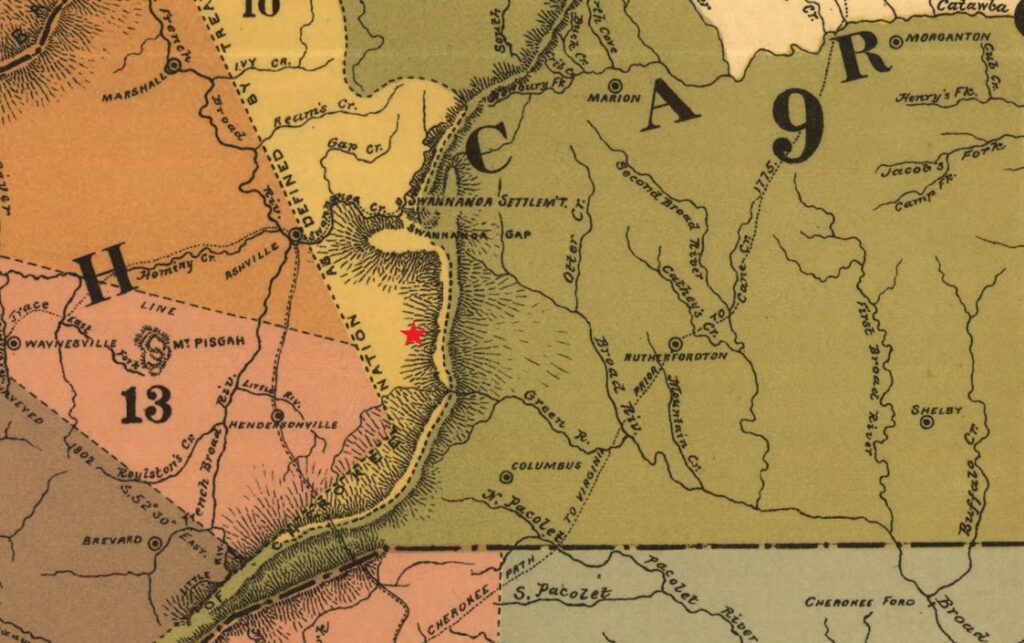
The 1884 Royce Map showing land cessation treaties with the Cherokees. The Ashworth cemetery is indicated by the red star in section 10A – land ceded in the 1785 Hopewell Treaty. - One specific impetus behind the treaty was that settlers were already squatting on Cherokee land west of the divide.
- The Cherokee officially held this land until a treaty in November of 1785. This 1785 Hopewell Treaty had several interesting points. The federal government and Cherokees agreed to prisoner exchange, and Article 5 states:
“If any citizen of the United States, or other person not being an Indian, shall attempt to settle on any of the lands westward or southward of the said boundary which are hereby allotted to the Indians for their hunting grounds, or having already settled and will not remove from the same within six months after the ratification of this treaty, such person shall forfeit the protection of the United States, and the Indians may punish him or not as they please: Provided nevertheless, That this article shall not extend to the people settled between the fork of French Broad and Holstein rivers, whose particular situation shall be transmitted to the United States in Congress assembled for their decision thereon, which the Indians agree to abide by.”
- After that point in 1785, white settlers began streaming into the area, and began finally registering deeds for property where they already resided.
Ashworth Family
- We discussed how the Ashworths fit into the bigger picture of WNC history.
- John Ashworth (1735-1805) married Nancy Ann Wood Ashworth (1745-1833).
- Nancy, who most everyone called Ann, was of Scots-Irish descent – her parents came from Ireland and may have been In what is now Wilkes County in the 1740s. They moved to the Fairview area in the 1760s, into territory still held by the Cherokees, when doing so was illegal.
- John Ashworth was born in Virginia and also apparently settled in Fairview in the 1760s.
- They had six children – Joseph, Mary, Johnson (John), Sarah, Suzanna, Elizabeth between 1770-1785 a fifteen year timespan.
- Sarah, their second daughter, married John McBrayer but both died and were buried in Georgia.
- The oldest son Joseph was buried in Tennessee.
- The dispersion of their children illustrates probably the two most common areas early settlers migrated to, though other Ashworth children and grandchildren ended up anywhere from Indiana to the Deep South.
Land Deeds and Speculation
- While John and Nancy certainly lived here for many years prior to it becoming legal to do so, Joseph Ashworth (the eldest son of John) was first to register a land deed. He began registering deeds in the Cane Creek area of Fairview in 1792, over 100 acres.
- 1794 – John purchased 50 acres from the state at rate of 34 shillings per 100 acres, so he paid 15 shillings for this land – less than one modern dollar.
- He ended up with 5 more state deeds over the next few years (450 acres) and his son John Jr bought 100 acres from the state.
- John Ashworth Sr. ended up with lands from Cane Creek to the Broad River, north of the Hickory Nut Gorge and from Fairview to the Bat Cave area –over 2,000 acres at once.
- John Sr. died in 1805 and some of his lands were deeded or sold.
- Before he died, he granted some lands (100 acres of a Broad River tract) to son in law John Williams (or Withrow), as the deed notes “for and in consideration of the love, good will, and affection which I have and do __ toward my loving son in law John Williams…” and also gave him over 340 acres along Cane Creek.
- That same year, he sold James Bridges 50 acres on Cane Creek for 150 pounds (almost $16,000 today).
- Land he had purchased for less than 1 dollar in 1790s went for the equivalent of $16,000 a decade later.
- 1807 – Nancy purchased a grant from the state for 75 acres lying on Stillhouse Branch and another branch which joins Ashworth Creek – 50 shillings for every 100 acres.
- John Jr. died in 1827 and Nancy Ann in 1833. It looks like John Jr. left much of his estate to siblings and their spouses – in 1822 had deeded 175 acres on Cane Creek to his son Joseph.
McBrayer Family
- Like the Ashworths, the McBrayer family buried here were also Scots Irish.
- Samuel McBrayer Sr. was born 1736 in Pennsylvania and died 1814.
- He received a land grant here for 300 acres in 1792 but family legend says he lived under a rock overhang for a year before building a house.
- Samuel’s first wife Elizabeth Ashe McBrayer of Pennsylvania died in 1787 at 46 years of age and it is thought she may be the first person buried here in this cemetery.
- Samuel’s second wife Mary Whitehouse McBrayer also of Pennsylvania died 1835. Her first husband John Young had died in 1780 after 4 years of marriage and two kids. She and Samuel then had children.
- Samuel Jr., their son, was ordered by the county in 1806 to be the road overseer, supervising other local men maintaining the rough road between Mine Hole Gap and the county line, basically modern Hwy74A or Charlotte Highway.
- The McBrayer descendants continued living here for decades, and we discussed some of their interesting stories later.
The Enslaved
- Oral tradition says that this cemetery may have also been used to bury enslaved people.
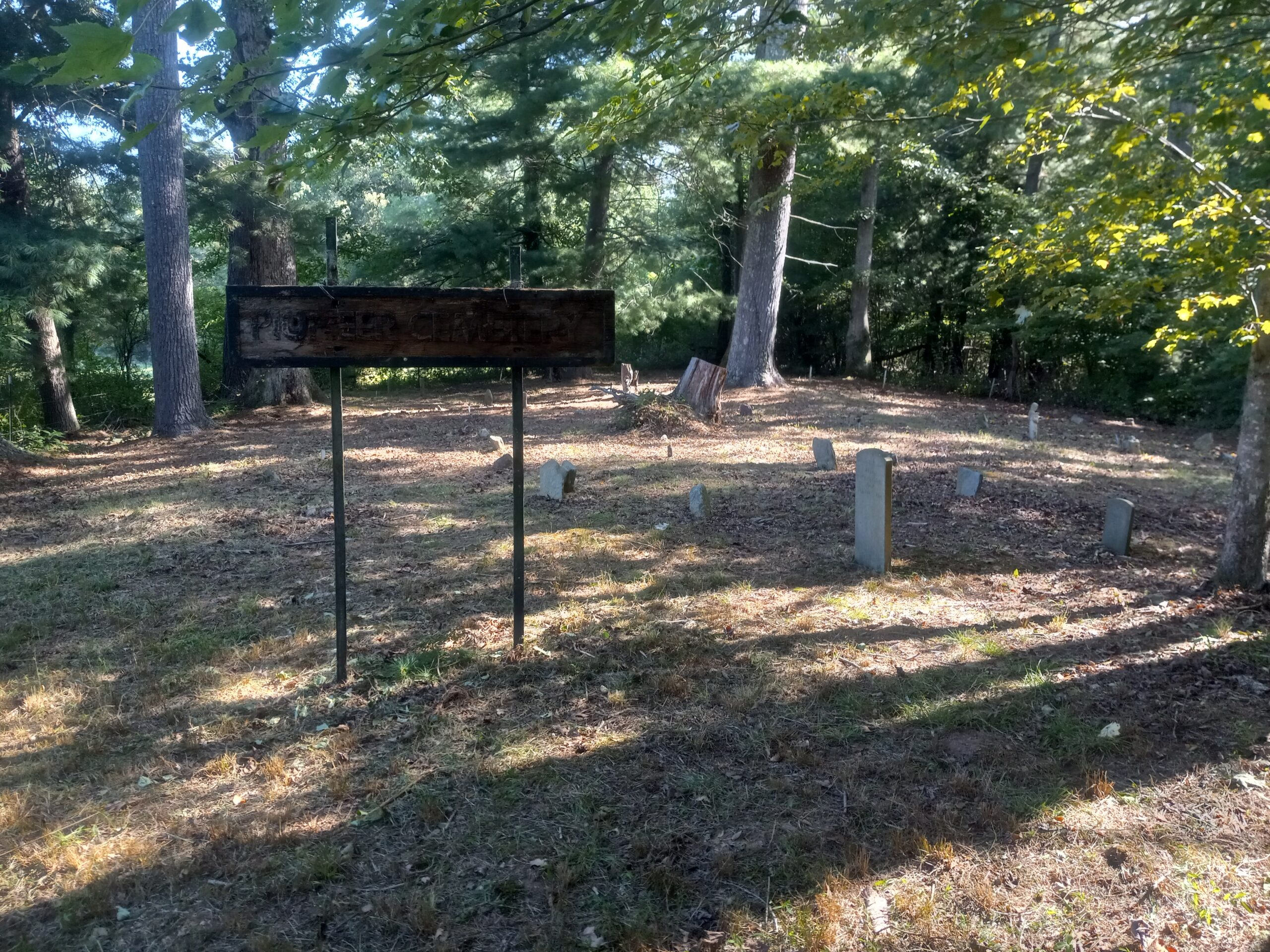
The cemetery is filled with numerous fieldstones in addition to the few carved headstones. - Being that the subject of this series is to humanize history and tell stories of common people, it is critical we try to give some life to people enslaved in the area who may have been interred here.
- The Ashworths were among the very first enslavers in this eastern area of Buncombe County and their story helps us understand the spread of slavery into the mountains.
- We know Ambrose Mills (one of the Loyalists executed at Biggerstaff’s) enslaved people in the foothills, and as we saw the previous week, it looks like Aaron and Martha Biggerstaff enslaved one man also.
- In 2018, Buncombe County Special Collections interviewed many Fairview locals including Sandy and Patty Lynch. They had heard maybe 50 enslaved people were buried here.
- They also recalled that Ashworth Creek had been rerouted when the highway was built and that supposedly a nearby ditch was part of a buffalo trail.
- It is certainly not unlikely that enslaved people could be buried in a family cemetery.
- Last year’s tour of the Absalom Dillingham cemetery in Barnardsville showed us just that. This is a family cemetery where those enslaved by the Dillinghams and other local families, as well as later free descendants were buried in a once-segregated cemetery.
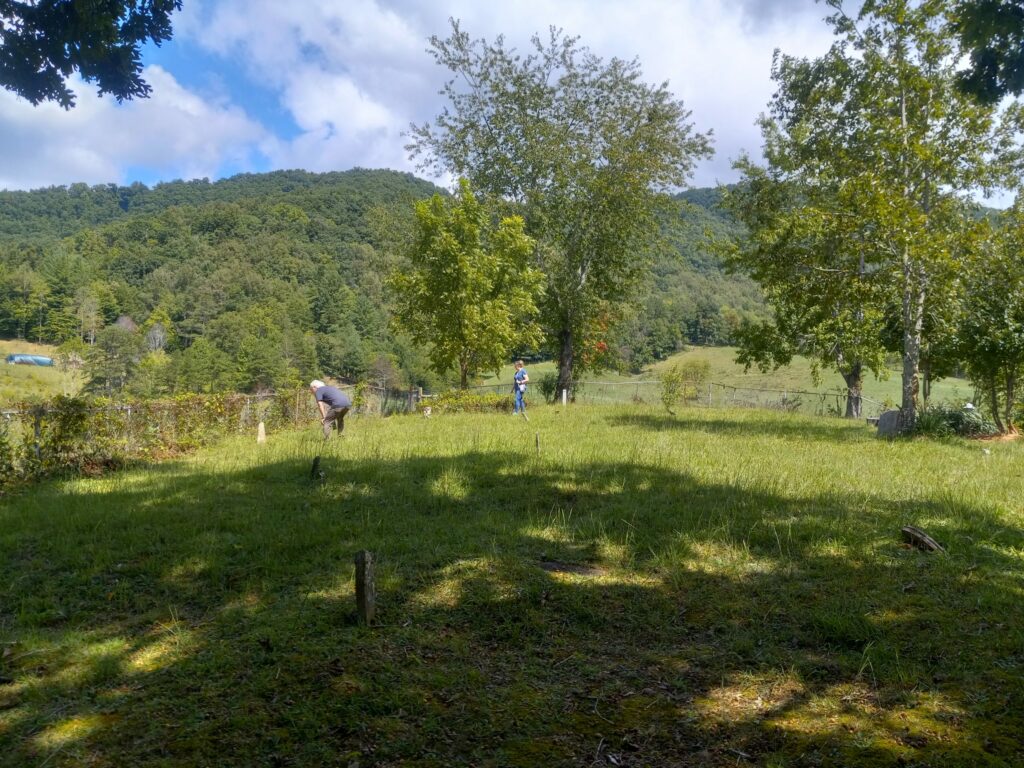
The historically Black section of the Dillingham cemetery in Barnardsville - But, the question remains as to who plausibly was buried here.
- Census records and wills may give us some clues.
1787 Morgan District Superior Court
- John Ashworth, implicated as a Loyalist (who supported or fought for British forces) had part of his property confiscated. But, due to “an error in the proceedings,” the court ordered “a Negro wench & child property of John Ashworth” returned to him.
1790 Census
- At the time, this area was still part of Rutherford County, but the 13th district was essentially the Hickory Nut Gorge/Fairview/Cane Creek area.
- John Ashworth enslaved 3 unnamed people.
- That year, in the immediate area, there were about 246 white settlers, and 9 total enslaved people held by 5 families.
1800 Census
- John Ashworth Sr. recorded 3 enslaved (presumably the same 3) – that year, 13 total people were enslaved in Asheville,
1809
- Nancy Ann paid $400 for a Black woman named Henny – 22-23 years old – from Jesse Anderson.
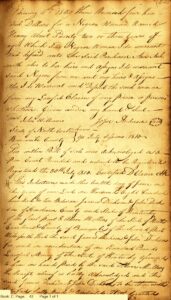
1810 census
- John Jr. had 2 enslaved while, Nancy Ann (age 45+) has 4 enslaved (presumably Henny plus the three from her deceased husband John) plus herself and one white adult male 45+ living in the household.
- In 1810, Buncombe Co had 18 free people of color, and counted 693 enslaved.
1813
- George Hill of South Carolina (Pendleton) sold to John Jr. 2 enslaved people – Fray (26 years old) and William (“a mullato boy” 18 months old) for $400.
1817
- William Moore of Buncombe sold to John Jr 1 – Dick – age 29-30
- William Moore sold to Nancy Ann – Rachal – 26 years old – for $175.
- I speculated as to whether they may have been a couple (marriages for the enslaved were not recognized legally or recorded until after emancipation in 1865).
1820 Census
- Nancy Ann had 4 total enslaved people (2 males age 26-45, 1 female 26-45, and 1 female 45+ in a household) where her and one white male are both 45+ years old.
- I assume that the oldest was Henny whom she purchased in 1809 and the younger female was Rachal whom she purchased three years prior.
- It is possible the two males held by Nancy were among the three people first purchased by John, and that the unidentified enslaved woman taken from and then returned to John Ashworth Sr. may have died by that point. She may have been buried in this cemetery.
- John Ashworth Jr., in a much larger family with numerous children, enslaved 1 male under 14 (likely William), 1 male 26-45 (likely Dick), 1 female under 14 (perhaps a child born there), and 2 females 26-45 (likely Fray and another unidentified woman OR POSSIBLY one of the three original people enslaved by John Sr.).
1821
- Nancy Ann sold Rachel to John Jr. – claimed her to be 28 years old – for $375.
1822
- Peter Lance of Buncombe County sold Jerry (age 16) to Nancy Ann – for $500.
1826
- William D. Smith of Buncombe sold Penelopy (age 30) Roman (age 6) Alford (age 4) and another boy Demsey (six months) to Nancy Ann for $1000.
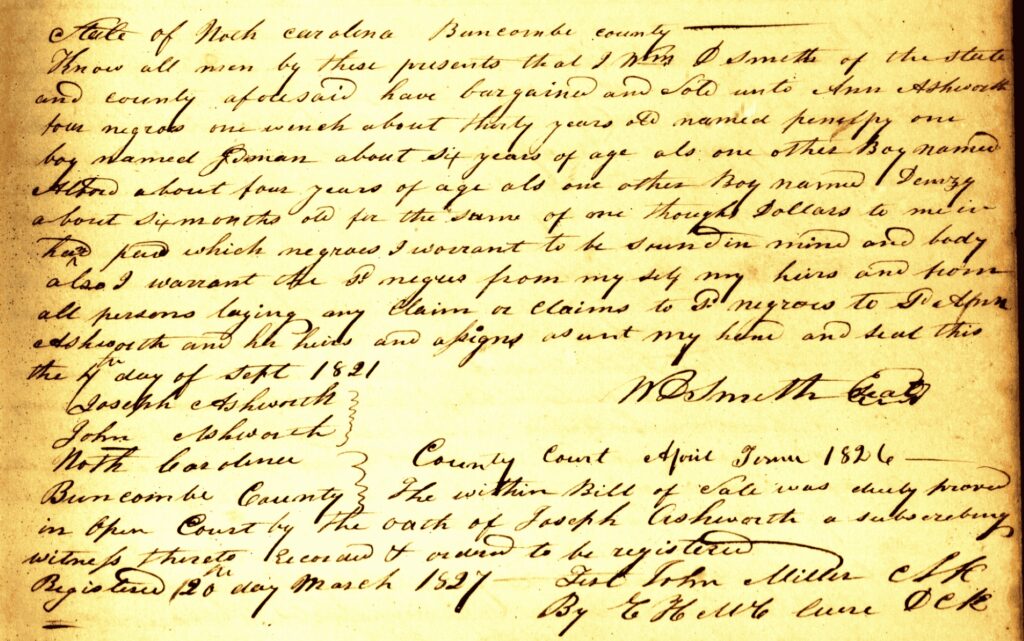
William Smith sold 4 people to Ann Ashworth in 1826, Buncombe County Register of Deeds, Book 13, 449 - These bills of sale for the enslaved were the last county-documented transactions Nancy made.
- She eventually held at least 8 enslaved people at one time.
- John Jr. had 6 people enslaved at once.
- By comparison, William Mills (who lived in a nearby part of Buncombe County that is now Henderson County) had 14 enslaved people in that same year.
1830 Census
- Ann lived with two daughters and had 7 enslaved (2 male infants, 2 males 10-24, 1 male 36-55, 1 female 36-55, 1 female 55+) people in the household.
- In May, 1830, in the North Carolina Spectator and Western Advertiser newspaper from Rutherfordton, Ann posted a wanted ad as Dick (who should have been enslaved by John Jr. at that time) ran away. Like many other examples, this runaway add helps shed light on the characteristics of an enslaved person. It is unknown if Dick escaped or was ever captured.
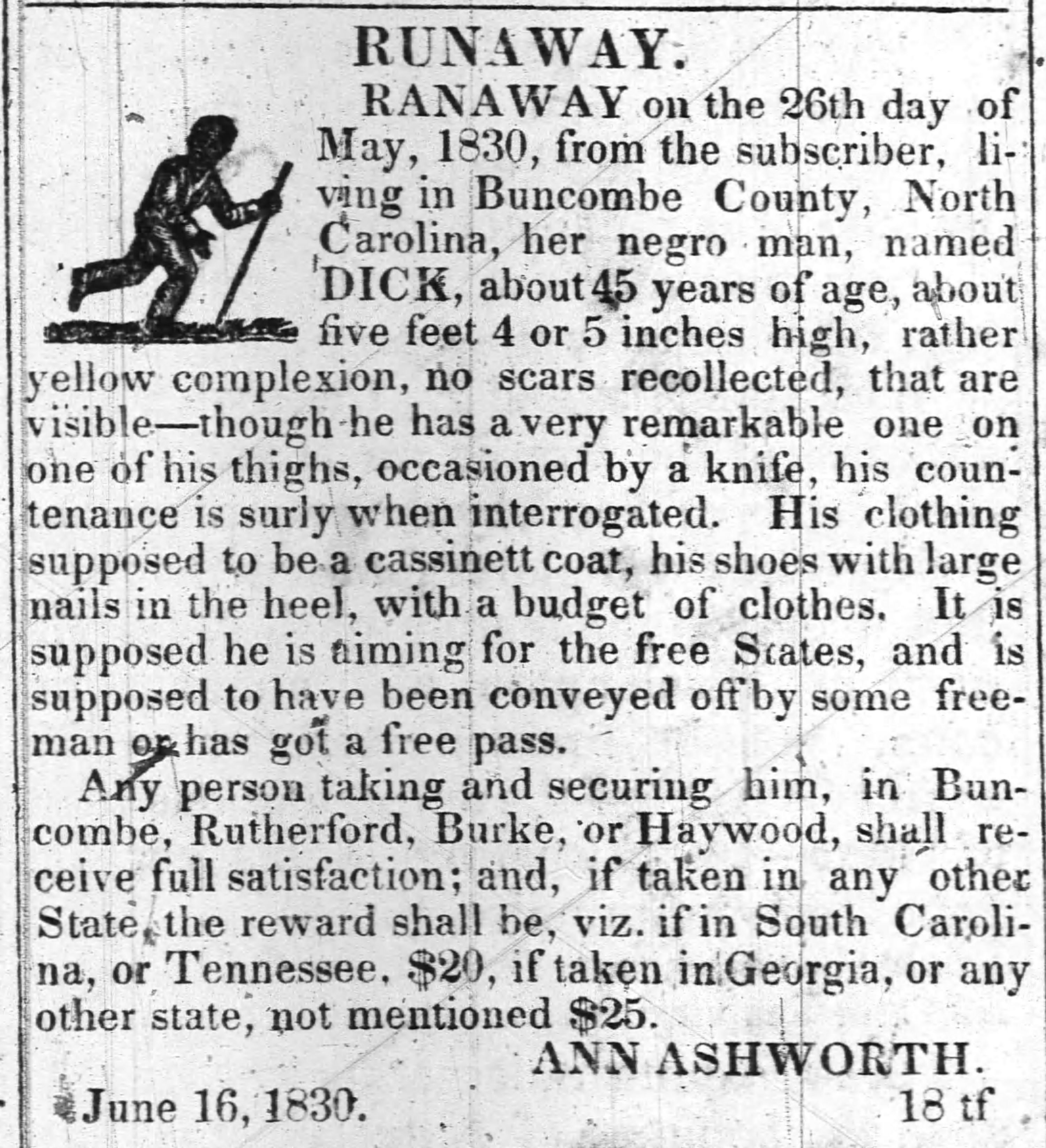

- In the same 1830 census, we first see James McBrayer (the first and possibly only McBrayer in the area listed as an enslaver) held 1 female under 10 and 1 male 10-24 in a household with 9 whites.
- Drafting his will in 1839, James left Mingo and Sall to his wife for the duration of her life and called their farm a planation. While it didn’t meet the usual definition of at least 20 enslaved laborers, this description does give some clue as to what their lives may have been like.
- James’ wife Mary (Polly) remarried after James died in 1851 and it is likely Mingo and Sall ended up with her and second husband in Andrews in Cherokee County.
1833
- Nancy Ann died and her estate was soon auctioned. She had written a will a few years prior and left several children and grandchildren various sums of money (over $100). Ann was clearly well off, and also showed favoritism as not all of the children or grandchildren received anything. Ann’s will had clearly deeded several enslaved people to certain relatives, but it is not clear this was followed.
- She called for her [grand?]daughter, Nancy to receive the enslaved, Hannah (Henny). After Nancy’s death, Hannah was to be set free, and Nancy’s sister, [Elizabeth?] Betsy Merrell, was to look after Hannah after she was freed. These two women lived and died in Henderson and Transylvania counties, and it is possible Henny or Hannah died and was buried there. At the estate sale, however, H.L. Laine purchased “one girl Hannah” for $162. Given that Henny or Hannah was over 55 years of age at the time, however, this may have been a child.
- Ann’s grandson, Shadrick Ashworth, was to receive the enslaved, Dempsey according to her will. Dempsey was 1 year old at time of the will. At the auction, however, William Withrow purchased “One boy Demse” for $413. Shadrick died in 1864, serving in the Union Army and was buried in Tennessee. It appears from the research of Withrow descendants that Dempsey indeed ended up in Georgia.
- Her grandson, Johnson Ashworth, was to receive George. Johnson died 1895 in Cane Creek and was buried at Fairview Church. George was not listed in any of the earlier bills of sale so it is unclear where he came from, how old he was, or where he ended up. It is possible he may have been one of the children in 1830 census. At the estate auction, Joseph Henry bought the young boys Edmond and Alford as well as “One likely Boy George” for about $1300 altogether.
- Nancy Ann left daughter Susannah Withrow her “Negro wench Nellisspy” (Penelope). Susannah married and moved to Georgia but Penelope may have died before that. Later in the 1830s, when estate administrators settled bad debts, someone was owed for building a coffin for “Nelly” who was described as an invalid. It is possible Penelope was buried in the cemetery.
- She left her daughter Elizabeth Merrell Caroll. It remains unclear who Carroll was or where she came from. Rachel and Penelope are believed to be the two women Nancy Ann enslaved in 1830 census.
- Finally, a “boy” named Dick was sold to Ephraim Henry for $227 but it is not clear if that is the Dick who escaped two years prior. He was over 45 years old at the time of escape, and the distinctive descriptions of Boy/Man were usually consistent in documents.
- Those unaccounted for by the will or estate auction were Roman (age 27) and Jerry (age 17).
- The sale brought in over $3,000, and almost 70% of that value came from the 6 enslaved people auctioned.
1840 census
- Jasper[?] Ashworth, a grandson of Samuel Sr., had a household of 4 people including 2 free Black females (likely mother/daughter) and 1 white male child.
- James McBrayer enslaved 1 male and 1 female between ages 10 and 24. Based on his will, they were likely Mingo and Sall, whom he left to his wife Polly.
- No other Ashworths or McBrayers in Buncombe County were recorded as enslavers in 1840.
Conclusions
- Some of those enslaved by the Ashworths were seemingly passed to children who moved away elsewhere, but it is entirely possible at least a few of the 15+ people they held may have lived their lives in the area and were buried here.
- The two most likely burials are the unidentified women first enslaved by John and Penelope.
- Since James McBrayer was the only known McBrayer enslaver and those two individuals likely went with his wife Polly and her second husband further west, it is not likely any people enslaved by the McBrayers were buried here.
- More research is needed to track the plight of those enslaved by John Jr.
- The possibility remains that those enslaved by other neighbors in the area may be among graves marked simply with fieldstones.
Nancy Ann as a Witch
Another very interesting oral tradition involving the people here is that Nancy Ann Ashworth was a witch or a healer.
- She lived as a widow from 1805 to her death in 1833 at nearly 88 years of age.
- She of course maintained a great deal of land once held by her husband, as well as many enslaved people – she was a very powerful woman in the community.
- To say nothing of those she held in slavery, there were certainly a few other people who did not necessarily like her.
- Those in the Cane Creek Church (now Fairview Baptist) brought her up on charges of witchcraft or other social taboos, such as drinking and wearing frilly petticoats according to oral tradition.
- She was rumored though to have a great self-taught practical knowledge of medicinal plants and could help neighbors, though many felt she could curse them as well.
Archetype
- Nancy Ann is a good example of a popular bit of mountain lore – the granny woman healer or witch.
- Cherokees, enslaved African Americans, and white settlers (particularly the Scots Irish) learned and frequently utilized a variety of medicinal plants, and the different cultures all maintained unique beliefs in healers or alternately evil doers.
- Here on the white frontier of settlement, Nancy Ann was at the intersection of all those different cultural traditions.
- According to North Carolina folklore collector Tom Peete Cross who penned an article on witchcraft superstitions in 1919, the first Europeans writing about Natives here, including John Lawson, believed they practiced witchcraft and worshipped the devil.
- As late as 1705 Grace Sherwood was tried for witchcraft in Princess Anne County Virginia. She was subjected to a trial by water where she floated but apparently was not prosecuted further as she lived several more decades.
- An early Kentucky historian writing about Appalachia noted that witches were reported to create incurable conditions – hairballs, killing cattle, making guns miss, turning men into horses, milking cows of neighbors by proxy from a dishrag – and also that men were capable of being witches but were rarely accused of using it for bad things. Male witches were most often reported to counteract spells of witches. The historian claimed to personally know several such men.
- Part of this lore held that witches needed to borrow something to get power over a family, and Cross note that many older widows in need of basic necessities were turned away by people in their communities because of the suspicion that they were witches.
- John Preston Arthur’s 1914 history of WNC told of a rumored witch, Granny Wiess, who lived near confluence of the French Broad and Davidson rivers in the early 1800s. Per the story, a man named Johnson consulted her to cure a medical condition and she told him he had to return money stolen from cattle buyer (how she knew this not explained). He was cured but found out as thief and had to flee.
- Cross wrote of a prevalent belief women could make themselves witches by taking a handkerchief and gun to a high mountaintop before sunrise and renouncing the Lord, accepting the devil, then shooting the handkerchief. If blood appeared she was accepted.
- Historian Patricia Beaver has argued that old age and widowhood afforded mountain grannies more respect. Their opinions were more valued and they were less subject to criticism for outspokenness of breaking social norms.
- Nancy Ann Ashworth certainly broke those norms. She was seen by many as kind of a wild card but undoubtedly did help people with her rudimentary healing, even if it was a placebo. She reportedly wrote down several of her curing rituals.
“1) To Cure Cancer: Go to a Savannah bush [I believe this is a holly] and say what did you come here for, to cure a cancer and brake off a twigg, then say who it is on, brake another twigg then say where the cancer is, brake another twigg down and go away, this must be done before sunrise three mornings in succession before speaking to any person.
2) The Cure for Heart Dropsy (heart failure): A cure for Dropsy, Take one gallon of hard cider and one hand full of Mile Cama (Camomile?) and a quantity of nales (nails) or other iron and some Horse Radish Roots, put it into a pot and over it close and boil it moderately down to one Quart, churin to top it. Close covered then take out the nales (nails), root and thin, add one quart of honey then boil down the whole of it to one quart.
3) A Cure for the Scald Head [falling out of hair]. Take one pound of May Butter one pound of green Tobacco, beat the Tobacco well and stew them moderately together untill the strength is intirely out of the tobacco, then take it out, then add one quarter of a pound of Black pepper when cool and mix them propperly together, thin it fitt fur use, shave the Head with sope (soap) and water, then grease the head and keep the same cloth untill the cure is finally cured.”
- She likely knew and used other plants such as pink lady slipper, which alongside other orchids was used as a sedative for pain, black cohosh which was used for menstrual and menopausal symptoms, spiderwort, which was used for insect bites and also thought to cure cancer, and bloodroot for treating ulcers, rheumatism, and fever
Recent Developments
McBrayer Descendants
- Many McBrayers continued to live here for generations – some still do.
- Things took an interesting turn in the 1920s with Charles McBrayer.
- Between 1925-26, he began selling tracts to the Hamilton Barrett Syndicate of Asheville for a planned Carolina’s Hollywood subdivision. They aimed to build hotels, golf courses, camps, pools, and to sell water and electricity.
- During this period, as Asheville experienced a boom, the company called this massive project in the still-rural countryside “the city inevitable.”
- They had branch offices in Columbia, SC, Raleigh, Charlotte, Savannah, Orlando, Indianapolis, and touted in late 1925 that 75% of lot buyers were from outside the area and were bringing in fresh blood.
- By mid-1927, however, the project had folded. The company did not begin to make any of the improvements and most buyers defaulted on payments. The company went into receivership and the Bankers Trust and Title Insurance Co sued and won against 17 buyers.
- I haven’t followed all the deeds to find out what happened to land, but we know development did not happen, until a project in 1949.
- This time, Charles McBrayer signed a ten year lease to George Hall, to build a ½ mile dirt stock car track in the field just a few hundred yards northeast of the cemetery.
- On September 25, 1949, regional drivers including Buck Baker inaugurated the quickly-built dirt ring. Louise Smith, one of the only female stock car racers in the area, also competed in the first season. This track, ten miles outside of Asheville, gained a reputation for having a tricky uneven surface, but marketed itself in 1955 as the only lighted track in the region for night racing. By the end of the 1956 season though, after several periods of repair and pauses in racing, the track seems to have ceased major operations.

A USDA aerial photograph showing the track in the 1950s. 
Asheville Citizen, Sep 10, 1955
Recent Cemetery Developments
- For over 100 years after the last known burial in 1855, little seemed to change in the cemetery.
- Locals recalled to me that they helped clean up the cemetery occasionally in the 1970s/1980s and that there may have been reunions or decoration ceremonies occasionally held by descendants.
- In the 1980s, Carl McBrayer also uncovered and helped clean a headstone for S McBrayer, which he believes is actually the infant son of John McBrayer (basically, the grandson of Samuel).
- In 2012, this land was put into a conservation easement with Southern Appalachian Highland Conservancy.
- David Hamilton, whose family have lived on and stewarded the property for several decades, also shared with the group the stories of the recent green burials of several family members on the edge of the cemetery.
- We noted as a group the long-standing and ongoing connection to the land and the place, shared by many different peoples, and the symbolism and tangible connections of this cemetery to that sense of place.
Sherrill’s Inn
- We were grateful to John and Annie Ager for showing us this historic property.
- The original Ashworth cabin still stands but was later incorporated into a much larger house used as an inn and livestock stand, operated by Bedford Sherrill and family after Nancy Ann Ashworth died. The ledgers from the inn are digitized and reveal fascinating insights into the travelers who ventured this way.
- Another structure on the property, an unassuming log cabin, contains gun ports, and is believed to be the fortified house built to shelter early white settlers during conflicts with Native peoples. This may possibly then be the oldest standing building in WNC.
- A spring coming off the mountain above (Ferguson Peak – named by William Mills in tribute to the fallen British Major Patrick Ferguson) still feeds a spring house with cool, clean water.
September 7, 2023

